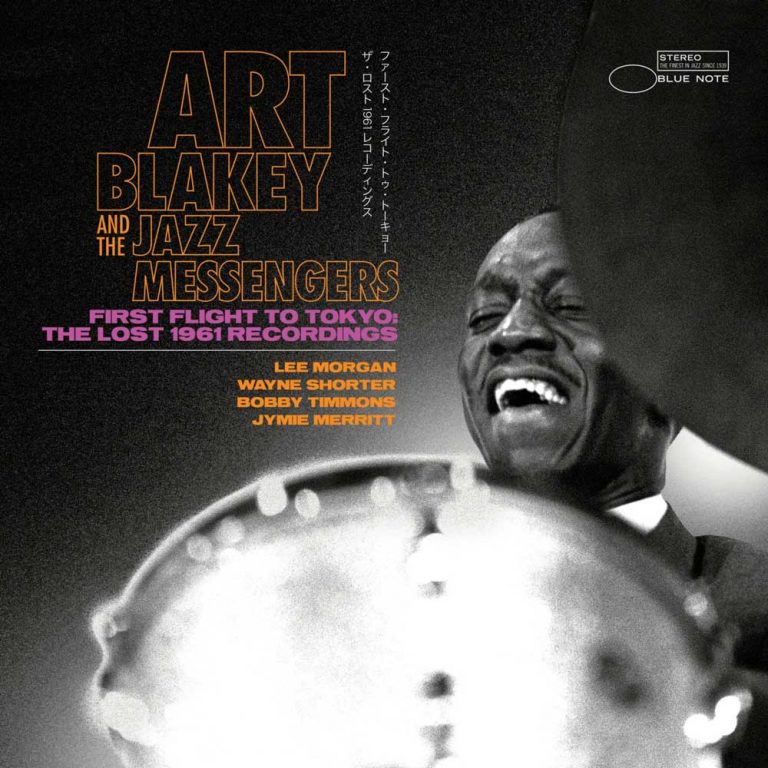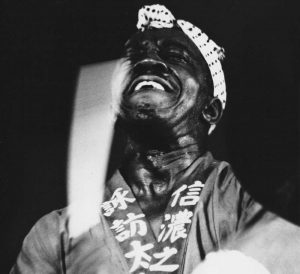“By January 1961 Art Blakey & The Jazz Messengers were big stars all over the world but they were still kind of stuck in a rut of playing noisy, smoky jazz clubs. That all changed when they arrived in Japan and became amongst the first American jazz musicians to perform in that country,” states Blue Note President Don Was in a film to accompany the release of Art Blakey & The Jazz Messengers “First Flight To Tokyo: The Lost 1961 Recordings.”
The album captures one of the greatest line-ups of The Jazz Messengers (Art Blakey on drums, Lee Morgan on trumpet, Wayne Shorter on tenor saxophone, Bobby Timmons on piano, and Jymie Merritt on bass) in full flight in the elegant surrounds of the Hibiya Public Hall, in Tokyo, on January 14th 1961. Designed by Koichi Sato and completed in 1929, the art deco building’s concert hall would prove the perfect setting for The Jazz Messengers first ever tour of Japan.

The tour came at a pivotal time in American history when music and politics were becoming ever more closely aligned. For a group of black jazz musicians, the experience would prove profound and long lasting. “This is right in the middle of the Civil Rights movement so to go to Japan and to be welcomed at the airport by tons of people… they were playing my dad’s music over the intercom. So a lot of this is really unfamiliar to a Black American at the time,” related the drummer’s third son Takashi Blakey in the same Blue Note film.
As a historical document, this lovingly presented Blue Note release is given even more weight thanks to a seriously deep booklet that includes essays by Bob Blumenthal, Wayne Shorter in conversation with Don Was, reflections from Takashi Blakey and musicians such as Lou Donaldson and Sadao Watanabe alongside the beautiful photography of Shunji Okura and Hozumi Nakadaira.
The tour came about after the Tokyo based cultural exchange group Art Friends Association asked people which American jazz group they would most like to visit the country. As Takashi Blakey explains in the liner notes: “Thousands upon thousands of Japanese fans knew The Jazz Messengers’ songs by heart and they could be seen nodding their heads in unison to the rhythm during his concerts.”
Pushed to the height of their powers by this reception, The Jazz Messengers performed one of the great live jazz sessions to be recorded and one that would prove significant in terms of America and Japan’s jazz connection. As you would expect the set includes many of the numbers that had launched The Jazz Messengers internationally.





The biggest of those was the Bobby Timmons-composed “Moanin’” that had first been recorded for Blue Note in 1958. The loud applause as Timmons’ piano hook opens the number is a sign of how The Jazz Messengers had become such stars in Japan. Another of those breakthrough numbers was “Dat Dere”, an equally inspired Timmons hard bop composition stretched out here over 12 majestic minutes. It’s a showcase both for the individual musicianship and collective intuition of this classic line-up of The Jazz Messengers fired by their explosive band leader. This is most evident on their breathtaking version of Dizzy Gillespie’s “A Night In Tunisia” where Blakey instructs Wayne Shorter to “whip it” during the saxophonists soaring solo at the 10-minute mark.
Of Art Blakey’s own playing, Don Was writes in the liner notes: “He was a master accompanist, a dynamic and dramatic musician who could summon up both a fiery intensity and a focused introspection. He could swing like nobody else and his drumming demanded that every musician dig in and play their best.” Just listen to his polyrhythmic soloing at the half way point of “A Night in Tunisia” or the thunderous five-minute opening of the 23-minute take on Charlie Parker’s “Now’s The Time” as the other legendary players respond to the challenge laid down.
The concert would have a lasting legacy both for American jazz in Japan and for Art Blakey personally. As Takashi Blakey say in the liner notes: “It’s no surprise that my father traveled to Japan almost every year for nearly 30 years following that first visit and maintained a lifelong love affair with the culture.”


ART BLAKEY & THE JAZZ MESSENGERS Art Blakey & The Jazz Messengers: First Flight to Tokyo: The Lost 1961 Recordings 2LP
Available to purchase from our US store.Andy Thomas is a London based writer who has contributed regularly to Straight No Chaser, Wax Poetics, We Jazz, Red Bull Music Academy, and Bandcamp Daily. He has also written liner notes for Strut, Soul Jazz and Brownswood Recordings.
Header photo: Art Blakey. Photo: Hozumi Nakadaira courtesy of Blue Note Records.


